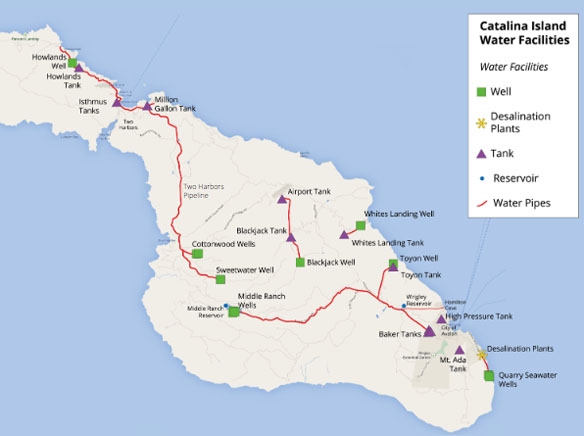Two Harbors project to remediate soil exposed to old pipeline materials
By Charles M. Kelly
Southern California Edison, which owns the water utility on the Island, is consideirng the replacement of the drinking water pipeline in Two Harbors.
Edison recently sent out a letter concerning the replacement, as well as creating a web page devoted to the project: www.sce.com/customer-service/faqs/catalina-water-pipeline-project.
Edison is planning summer community meetings about the Catalina Water Pipeline project, according to the letter, which was signed by Anthony Hernandez, director of Catalina Operations and Strategy.
“We want to inform you about an upcoming water infrastructure project currently focused on soil remediation efforts but will ultimately include the replacement of our Two Harbors water pipeline, which feeds the western part of the island,” Hernandez wrote.
“This remediation is focused on the soil surrounding the pipeline and not the drinking water itself; water samples confirm that the drinking water in the system meets or exceeds California’s drinking water standards,” Hernandez wrote.
Near the end of the letter, another paragraph repeats that information.
“You can also expect to be notified about this project by the California Department of Toxic Substance[s] Control which will provide direct communication to all island residents to inform them of SCE’s soil remediation efforts,” Hernandez wrote.
“During the 1960s, materials commonly used across the country that met industry standards of that time were used for infrastructure upgrades to ensure adequate service to customers,” Hernandez wrote.
“Some components of the country’s 1960s-era water infrastructure systems, including Catalina’s, contain regulated materials that pose potential health risks,” Hernandez wrote.
“Specifically, the U.S. Environmental Protection Agency and the TDSC, respectively, regulate two materials commonly found in pipeline coatings: polychlorinated biphenyls (PCBs) and polycyclic aromatic hydrocarbons (PAHs),” Hernandez wrote.
According to the Catalina Water Pipeline Project website, Edison has been routinely testing for the presence of PCBs and PAHs since the discovery of those material in some elements of the Island water infrastructure
“Ongoing repair, improvement and replacement projects are needed to maintain the long-term reliability of Catalina’s system, and these projects will provide an opportunity to replace the materials used in the infrastructure,” Hernandez wrote.
According to the letter, the project involves 8 miles of in-service pipeline in Two Harbors and 1 mile of decommissioned pipeline.
“SCE has conducted an analysis to identify the extent of the PCB and PAH contamination in the surrounding soil,” Hernandez wrote.
Edison is working on evaluating the replacement of the pipeline, according to the letter.
In addition to Edison’s website for the project, the Department of Toxic Substances Control has set up a project site at www.envirostor.dtsc.ca.gov/public/profile_report?global_id=60002989.
“The source of the contamination is the steel pipeline containing asbestos which includes a coal-tar exterior wrap and coal tar enamel interior lining,” according to Envirostor, the Department of Toxic Substances Control’s data management system.
“Investigation results indicated that asbestos associated with coal tar exterior wrap was not present in the soil, while PAHs and PCBs were encountered in several areas,” according to Envirostor.
“SCE is undertaking additional assessments that will inform remedial alternatives for the Site,” according to Envirostor.
“In addition to the required compliance monitoring, SCE has installed filter systems and implemented a program to routinely assess for the possible presence of PCBs in the Two Harbors Water System,” according to Envirostor.











